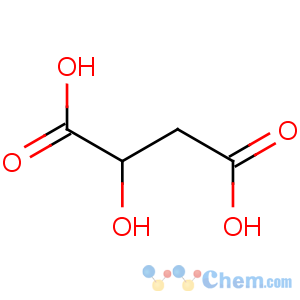Title: Malic Acid
CAS Registry Number: 6915-15-7
CAS Name: Hydroxybutanedioic acid
Synonyms: hydroxysuccinic acid
Molecular Formula: C4H6O5
Molecular Weight: 134.09
Percent Composition: C 35.83%, H 4.51%, O 59.66%
Literature References: The naturally occurring isomer is the L-form which has been found in apples and many other fruits and plants. Prepn of D- and DL-forms, and resolution of racemic mixture: McKenzie
et al., J. Chem. Soc. 123, 2875 (1923). Solubilities: Descamps,
Bull. Soc. Chim. Belg. 49, 91 (1940). Microbial production of L-form: Kitahara; Abe
et al., US 2972566;
US 3063910 (1961, 1962, both to Kyowa). Configuration: J. A. Mills, W. Klyne in
Progress in Stereochemistry vol. 1, W. Klyne, Ed. (Academic Press, New York, 1954) pp 182-183; E. L. Eliel,
Stereochemistry of Carbon Compounds (McGraw-Hill, New York, 1962) pp 97-98; Cymerman-Craig, Roy,
Tetrahedron 21, 1847 (1965). Review of uses:
Manuf. Chem. Aerosol News 35, 56 (December, 1964).
Review: S. E. Berger, "Hydroxy Dicarboxylic Acids" in
Kirk-Othmer Encyclopedia of Chemical Technology vol 13 (Wiley-Interscience, New York, 3rd ed., 1981) pp 103-110.
Derivative Type: DL-Form
CAS Registry Number: 617-48-1
Properties: Crystals, mp 131-132°. Soly in g/100 g solvent at 20°: methanol 82.70, diethyl ether 0.84, ethanol 45.53, acetone 17.75, dioxane 22.70, water 55.8. Practically insol in benzene.
Melting point: mp 131-132°
Derivative Type: D-(+)-Form
CAS Registry Number: 636-61-3
Properties: Crystals, mp 101°.
Melting point: mp 101°
Derivative Type: L-(-)-Form
CAS Registry Number: 97-67-6
Synonyms: Apple acid
Properties: Crystals from acetone, or acetone + CHCl3, mp 100°. Dec ~140°. [a]D -2.3° (c = 8.5). Soly in g/100 g solvent at 20°: methanol 197.22, diethyl ether 2.70, ethanol 86.60, acetone 60.66, dioxane 74.35, water 36.35. Practically insol in benzene.
Melting point: mp 100°
Optical Rotation: [a]D -2.3° (c = 8.5)
Use: Intermediate in chemical synthesis. Chelating and buffering agent. Flavoring agent, flavor enhancer and acidulant in foods.

